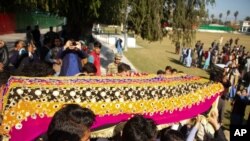The Afghan Taliban are deliberately targeting, intimidating and killing journalists, particularly women, according to a new report issued Thursday by an international rights group as well as VOA’s own research.
Human Rights Watch found militant commanders in areas under Taliban influence use direct threats and violence to try and control the media coverage of their activities. In areas beyond their control, they use oral or written threats through phones, letters, and social media.
“Those making the threats often have an intimate knowledge of a journalist’s work, family, and movements and use this information to either compel them to self-censor, leave their work altogether, or face violent consequences,” the HRW report said.
Taliban spokesman Zabihullah Mujahid rejected the claims, calling them “unfounded and based on Kabul’s intelligence agencies.”
“We have been from the outset condemning these targeted killings and stating that Taliban have nothing to do with them. It is a matter of grave concern for us that such a reputable international organization has used baseless information and became part of a propaganda campaign seeking to malign Taliban,” he told VOA.
HRW interviewed 46 media workers in multiple provinces between November 2020 and March 2021 and reported that local Taliban commanders seem to have the authority to make their own decisions in terms of targeting journalists, without approval from senior Taliban leadership.
“The commanders have considerable autonomy to carry out punishments, including targeted killings,” the report said.
“By silencing critics through threats and violence, the Taliban have undermined hopes for preserving an open society in Afghanistan,” said Patricia Gossman, associate Asia director.
The information provided in the report corresponds with other similar reports, including one from Afghan Journalists Safety Committee, that suggest targeting of journalists spiked in the period soon after direct negotiations started in September 2020, between Taliban and an Afghan government-sanctioned team in Doha.
At least eight journalists were killed in the span of a couple of months. Unlike the past, none of those attacks were claimed by Taliban and a few were claimed by the Islamic State group.
The HRW report mentions specific examples collected from across the country to make its case.
A journalist in Kandahar told the rights group that the Taliban threatened him when he refused to beef up the casualty figure in a suicide attack. Another journalist in the province received threats within minutes of reporting a Taliban attack on a civilian facility.
In Helmand, journalists were targeted for covering the Taliban’s military operations.
“In the months before he was killed by an improvised explosive device (IED) on November 11, Elyas Dayee, a journalist, had received multiple threats from Taliban commanders in Helmand, warning him to stop his reporting on their military operations,” the report said.
Multiple journalists said the Taliban called and accused them of giving the government publicity.
One journalist reported receiving a call and a threat to “count down to his death” when he refused Taliban demands.
In Baghdis, a radio station was threatened after it reported the Taliban extorting payments from highway drivers.
“The martyrs of the Islamic Emirate will soon kill the employees of this media station,” a comment under the report said on the station’s Facebook page.
In parts of the country, local Taliban commanders threatened stations that broadcast music, according to the rights group.
“A caller shared a lot of information about me as proof that they have been watching me – he told me my name, my father’s name, where I work, and the address of my house … after a few days, I got a message saying ‘the path you have chosen is not the right path, so you should move on from it or else we will decide what to do with you,’” a journalist in Khost province told HRW.
Women journalists have faced threats not just because of their work but also due to their gender.
“The letter repeated that I must not work anymore for news agencies because this job doesn't suit me morally,” a Kabul based female journalist told HRW.
Multiple female journalists, including some famous names in Afghanistan, have either left their profession or left the country due to direct threats.
In Ghazni province, the Taliban have instructed media outlets that the hosts of entertainment programs should not be women, and that no music should be broadcast.
While a majority of threats come from Taliban since they are the biggest group and have control or influence over the large swaths of the country, other groups also threaten or target journalists in areas where they operate.
In Nangarhar province, for example, which has long been a base for the Islamic State Khorasan Province (ISKP), the group has claimed responsibility for killing four female journalists from the same station, Enikass Radio and Television, in December and March.
According to AJSC, 14 female media workers were threatened or attacked last year.
In conversations with various journalists across the country, VOA found that the are scared of the Taliban and are unwilling to give on-the-record interviews, fearing for their lives and those of their loved ones.
Ayaz Gul contributed to this report.
Human Rights Watch Accuses Taliban of Targeting, Killing Journalists




